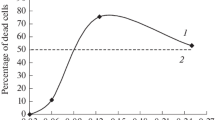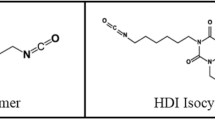Summary
The hyperproliferative human keratinocyte line (HaCaT) was tested for dithranol tolerance (tachyphylaxis) at the cellular level. At day 4 after seeding, keratinocytes were treated with 0.3 or 1.0 ΜM dithranol. Data were compared with those from experiments including additional pretreatments with 0.3 ΜM at day 3, or at days 1 and 3. Protein content, DNA synthesis and protein synthesis (incorporation of 3H-thymidine and 14C-amino acids per protein) were determined at 24, 48 and 72 h after the last drug exposure. Protein content of attached cells decreased in relation to dose and frequency of treatments. Inhibition of DNA and protein synthesis (38.2% and 32.3%, respectively) also occurred 24 h after a single treatment with 0.3 ΜM dithranol, but was only 18.4% and 9.1% after pretreatment twice with 0.3 ΜM dithranol. This tolerance reaction in vitro, after repeated dithranol exposure of human keratinocytes, may be explained by a selective loss of drug-sensitive cells.
Similar content being viewed by others
References
Ashton RE, Andre P, Lowe NJ, Whitefield M (1983) Anthralin: historical and current perspectives. J Am Acad Dermatol 9:173–192
Bedord CJ, Young JM, Wagner BM (1983) Anthralin inhibition of mouse epidermal arachidonic acid lipoxygenase in vitro. J Invest Dermatol 81:566–571
Bonnekoh B, Wevers A, Jugert F, Merk H, Mahrle G (1989) Colorimetric growth assay for epidermal cell cultures by their crystal violet binding capacity. Arch Dermatol Res 281:487–490
Bonnekoh B, Farkas B, Geisel J, Mahrle G (1990) Lactate dehydrogenase release as an indicator for dithranol induced membrane injury in cultured human keratinocytes — A time profile study. Arch Dermatol Res 282:325–329
Bonnekoh B, Tanzer H, Seidel M, Geisel J, Merk HF, Wiegrebe W, Mahrle G (1991) Structural — functional relationship of new anthralin derivatives assayed for growth inhibition and cytotoxicity in human keratinocyte cultures. Arch Pharm (Weinheim) (in press)
Boukamp P, Petrussevska RT, Breitkreutz D, Hornung J, Markham A, Fusenig NE (1988) Normal keratinization in a spontaneously immortalized aneuploid human keratinocyte cell line. J Cell Biol 106:761–771
Brandt H, Mustakallio KK (1983) Irritation and staining by dithranol (anthralin) and related compounds. III. Cumulative irritancy and staining during repeated chamber testing. Acta Derm Venereol (Stockh) 63:237–240
Brown WR, Rogozinski TT, Ramsey CA (1988) Anthralin and tar with UVB increase epidermal cell proliferation in asebia mice. Clin Exp Dermatol 13:248–251
Brown WR, Furukawa RD, Ramsay CA (1989) UVB radiation further stimulates proliferation in the already hyperproliferative epidermis of the asebia mouse. Arch Dermatol Res 281:366–367
Cavey D, Caron JC, Shroot B (1981) Anthralin: chemical instability and glucose-6-phosphate dehydrogenase inhibition. Br J Dermatol 105 [Suppl 20]:15–19
Clark JM, Hanawalt PC (1982) Inhibition of DNA replication and repair by anthralin or danthron in cultured human cells. J Invest Dermatol 79:18–22
De Mare S, Calis N, Hartog G den, Erp PEJ van, Kerkhof PCM van de (1988) The relevance of salicylic acid in the treatment of plaque psoriasis with dithranol creams. Skin Pharmacol 1:259–264
De Mare S, Calis N, Hartog G den, Kerkhof PCM van de (1989) Outpatient treatment with short-contact dithranol. The impact of frequent concentration adjustments. Acta Derm Venereol (Stockh) 69:449–451
Duvall E, Wyllie AH (1986) Death and the cell. Immunol Today 7:115–119
Du Vivier A (1976) Tachyphylaxis to topically applied steroids. Arch Dermatol 112:1245–1248
Du Vivier A, Stoughton RB (1975) Tachyphylaxis to the action of topically applied corticosteroids. Arch Dermatol 111:581–583
Fuchs J (1988) Validity of the “bioassay” for thioredoxin-reductase activity. Arch Dermatol 124:849–850
Fuchs J, Packer L (1989) Investigation of anthralin free radicals in model systems and in skin of hairless mice. J Invest Dermatol 92:677–682
Fuchs J, Zimmer G, Wölbling RH, Milbradt R (1986) On the interaction between anthralin and mitochondria: a revision. Arch Dermatol Res 279:59–65
Galewsky (1916) über Cignolin, ein ErsatzprÄparat des Chrysarobins. Dermatol Wochenschr 6:113–115
Kanerva L (1990) Electron microscopy of the effects of dithranol on healthy and on psoriatic skin. Am J Dermatopathol 12:51–62
Kemeny L, Ruzicka T, Braun-Falco O (1990) Dithranol: a review of the mechanism of action in the treatment of psoriasis vulgaris. Skin Pharmacol 3:1–20
Klem EB (1978) Effect of antipsoriasis drugs and metabolic inhibitors on the growth of epidermal cells in culture. J Invest Dermatol 70:27–32
Lawrence CM, Shuster S (1985) Mechanism of anthralin inflammation. 2. Effect of pretreatment with glucocorticoids, anthralin and removal of stratum corneum. Br J Dermatol 113:117–122
Lotti T, Brunetti L, Panconesi E (1986) A ‘novel’ action of anthralin. Arch Dermatol 122:748–749
Luthman M, Holmgren A (1982) Rat liver thioredoxin and thioredoxin reductase: purification and characterization. Biochemistry 21:6628–6633
Mann HB, Whitney DR (1947) On a test of whether one of two random variables is stochastically larger than the other. Ann Math Statist 18:50–60
Morliére P, Dubertret L, Sa E Melo T, Salet C, Fosse M, Santus R (1985) The effect of anthralin (dithranol) on mitochondria. Br J Dermatol 112:509–515
Müller K, Wiegrebe W, Younes M (1987) Dithranol, active oxygen species and lipid peroxidation in vivo. Arch Pharm (Weinheim) 320:59–66
Plumier E, Wappes B, Wiegrebe W (1984) Incorporation of 3H-thymidine into DNA: inhibition of dithranol and its di- and triacetate. Arch Dermatol Res 276:406–408
Prunieras M, Delescluse C (1984) Epidermal cell culture systems in skin pharmacology. Br J Dermatol 27:43–47
Pullmann H, Enderer K, Steigleder GK (1981) Cytokinetic effects of anthralin on psoriatic keratinocytes. Br J Dermatol 105 [Suppl 20]:55–56
Reichert U (1986) Skin toxicity and cellular metabolism: in vitro models. Br J Dermatol 115 [Suppl 31]:108–116
Reichert U, Jacques Y, Grangeret M, Schmidt R (1985) Antirespiratory and antiproliferative activity of anthralin in cultured human keratinocytes. J Invest Dermatol 84:130–134
Retzow A, Plumier E, Wiegrebe W (1981) Untersuchungen zur Hemmung der Glukose-6-Phosphat-Dehydrogenase durch Dithranol. Pharm Zeitg 126:2150–2155
Schaefer H, Schalla W, Shroot B (1981) Anthralip-facts, trends and unresolved problems. Zentralbl Haut Geschlechtskrankh 146:273–282
Schallreuter KU, Pittelkow MR (1987) Anthralin inhibits elevated levels of thioredoxin reductase in psoriasis — A new mode of action for this drug. Arch Dermatol 123:1494–1498
Schallreuter KU, Wood JM (1989) Free radical reduction in the human epidermis. Free Radic Biol Med 6:519–532
Schulze HJ, Schauder S, Mahrle G, Steigleder GK (1987) Combined tar-anthralin versus anthralin treatment lowers irritancy with unchanged antipsoriatic efficacy. J Am Acad Dermatol 17:19–24
Shroot B, Schalla W, Schaefer H (1985) Anthralin. In: Roenigk HH, Maibach HI (eds) Psoriasis. Marcel Dekker, New York Basel, p 329
Steigleder GK, Schumann H, Lennartz KJ (1973) Autoradiographic in vitro examination of psoriatic skin before, during and after dithranol treatment. Arch Dermatol Forsch 246:231–235
Tucker WFG, MacNeil S, Dawson RA, Tomlinson S, Bleehen SS (1986) An investigation of the ability of antipsoriatic drugs to inhibit calmodulin activity: a possible mode of action of dithranol (anthralin). J Invest Dermatol 87:232–235
Yoshino K, Maibach HI (1985) Kinetics of epidermal DNA synthesis in hairless mice after multiple anthralin application. J Invest Dermatol 84:325
Author information
Authors and Affiliations
Additional information
This study was supported in part by the W.-Doerenkamp-Foundation. B. F. from the Department of Dermatology, Albert Szent-Györgyi Medical University of Szeged, Hungary, is a fellow of the Alexander-von-Humboldt-Foundation. On the occasion of the 65th birthday of Prof. Dr. Dr. h. c. G. K. Steigleder
Rights and permissions
About this article
Cite this article
Farkas, B., Bonnekoh, B. & Mahrle, G. Repeated treatment with dithranol induces a tolerance reaction in keratinocytes in vitro. Arch Dermatol Res 283, 337–341 (1991). https://doi.org/10.1007/BF00376624
Received:
Issue Date:
DOI: https://doi.org/10.1007/BF00376624




